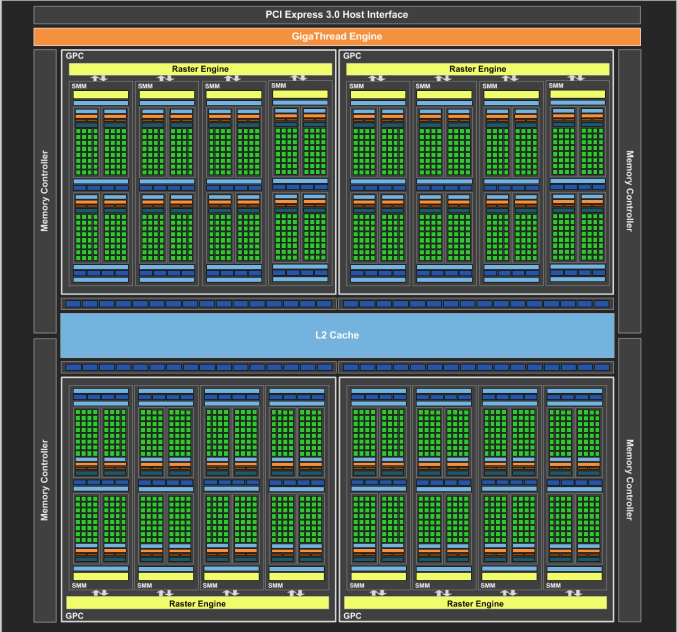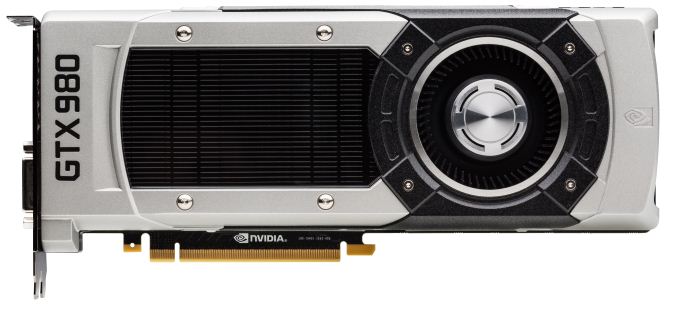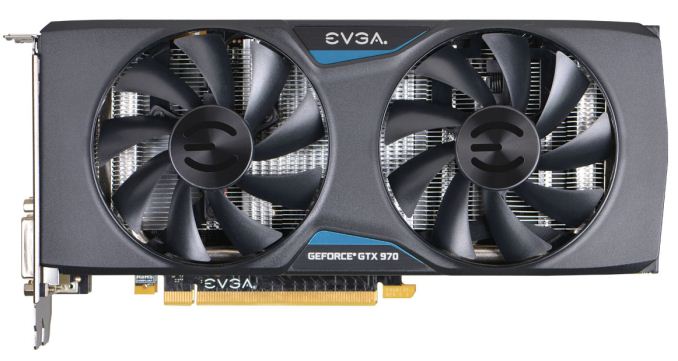The NVIDIA GeForce GTX 980 Review: Maxwell Mark 2
by Ryan Smith on September 18, 2014 10:30 PM ESTLaunching Today: GTX 980 & GTX 970
Now that we’ve had a chance to take a look at the architectural and feature additions found in Maxwell 2 and GM204, let’s talk about the products themselves.
Today NVIDIA will be launching 2 products. These are the GeForce GTX 980 and GeForce GTX 970. As with past 80/70 parts this is a two tier launch, with GTX 980 being NVIDIA’s new flagship card and 1st tier GM204 card, while GTX 970 offers 2nd tier performance at much lower pricing.
| NVIDIA GPU Specification Comparison | ||||||
| GTX 980 | GTX 970 (Corrected) | GTX 780 Ti | GTX 770 | |||
| CUDA Cores | 2048 | 1664 | 2880 | 1536 | ||
| Texture Units | 128 | 104 | 240 | 128 | ||
| ROPs | 64 | 56 | 48 | 32 | ||
| Core Clock | 1126MHz | 1050MHz | 875MHz | 1046MHz | ||
| Boost Clock | 1216MHz | 1178MHz | 928Mhz | 1085MHz | ||
| Memory Clock | 7GHz GDDR5 | 7GHz GDDR5 | 7GHz GDDR5 | 7GHz GDDR5 | ||
| Memory Bus Width | 256-bit | 256-bit | 384-bit | 256-bit | ||
| VRAM | 4GB | 4GB | 3GB | 2GB | ||
| FP64 | 1/32 FP32 | 1/32 FP32 | 1/24 FP32 | 1/24 FP32 | ||
| TDP | 165W | 145W | 250W | 230W | ||
| GPU | GM204 | GM204 | GK110 | GK104 | ||
| Transistor Count | 5.2B | 5.2B | 7.1B | 3.5B | ||
| Manufacturing Process | TSMC 28nm | TSMC 28nm | TSMC 28nm | TSMC 28nm | ||
| Launch Date | 09/18/14 | 09/18/14 | 11/07/13 | 05/30/13 | ||
| Launch Price | $549 | $329 | $699 | $399 | ||
Starting with the GeForce GTX 980, this is a fully enabled GM204 part. This means that 16 SMMs are enabled (2048 CUDA cores), as are all 64 ROPs and the full 256-bit memory bus. It is in other words GM204 at its best.
For clockspeeds NVIDIA is shipping GTX 980 with a base clockspeed of 1126MHz, a boost clockspeed of 1216MHz, and in our samples we have found the maximum clockspeed (highest stock boost bin) to be 1252MHz. This is a higher set of clockspeeds than any NVIDIA consumer GPU thus far, surpassing GTX 770, GTX Titan Black, and GTX 750 Ti. Curiously NVIDIA’s self-defined (and otherwise arbitrary) boost clock is much higher than on past parts; normally it would only be 50MHz or so above the base clock. This indicates that NVIDIA is getting more aggressive with their boost clock labeling and are picking values much closer to the card’s maximum clockspeed. This is a subject we will be revisiting later.
Meanwhile the memory clock stands at 7GHz, the same as with NVIDIA’s past generation of high-end cards. With GDDR5 clockspeeds all but tapped out, NVIDIA appears to have reached the limits of GDDR5 as a technology, hence their long-term interest in HBM for future architectures and improved color compression for current architectures. In any case this 7GHz of GDDR5 is attached to a 256-bit memory bus, and is populated with 4GB of VRAM. NVIDIA for the longest time has held to 2GB/3GB of memory for their cards, so it is a welcome sight to see that they are now making 4GB their standard, especially if they are going to target 4K gaming.
For power delivery GTX 980 has a rated TDP of 165W. This is significantly lower than the 250W TDPs of the GTX 780/780Ti/Titan and even the 225W TDP of the GTX 770, and heavily contributes to NVIDIA’s overall power efficiency advantage. Meanwhile NVIDIA does not specify an idle TDP, however in our testing idle power usage is lower than ever for a high-end NVIDIA card, indicating that NVIDIA should have it down to the single watt range.
Moving on, we have the GTX 980’s lower price, lower performance counterpart, the GTX 970. Compared to GTX 980, GTX 970 drops 3 of the SMMs, reducing its final count to 13 SMMs or 1664 CUDA cores. It also sheds part of a ROP/L2 cache partition while retaining the 256-bit memory bus of its bigger sibling, bringing the ROP count down to 56 ROPs and the L2 cache down to 1.75MB, a configuration option new to Maxwell.
As expected, along with the reduction in SMMs clockspeed is also reduced slightly for GTX 970. It ships at a base clockspeed of 1050MHz, with a boost clockspeed of 1178MHz. This puts the theoretical performance difference between it and the GTX 980 at about 85% of the ROP performance or about 79% of the shading/texturing/geometry performance. Given that the GTX 970 is unlikely to be ROP bound with so many ROPs, the real world performance difference should much more closely track the 79% value, meaning there is a significant performance delta between the GTX 980 and GTX 970. Elsewhere the memory configuration is unchanged from GTX 980. This means we’re looking at 4GB of GDDR5 clocked at 7GHz, all on a 256-bit bus.
GTX 970’s TDP meanwhile is lower than GTX 980’s thanks to the reduced clockspeeds and SMM count. The stock GTX 970 will be shipping with a TDP of just 145W, some 80W less than GTX 770. NVIDIA’s official designs still include 2 6-pin PCIe power sockets despite the fact that the card should technically be able to operate on just one; it is not clear at this time whether this is for overclocking purposes (150W would leave almost no power headroom) or for safety purposes since NVIDIA would be so close to going over PCIe specifications.
Due to the launch of the GTX 980 and GTX 970, NVIDIA’s product lineup will be changing to accommodate these cards. GTX 780 Ti, GTX 780, and GTX 770 are all being discontinued; their replacements offer better performance at better prices for lower power consumption. GTX 980 will be launching at $550, meanwhile GTX 970 will be launching at the surprisingly low price of $329, some 40% cheaper than GTX 980. On a historical basis GTX 980 is a bit higher than most of the past GTX x80 cards – which are often launched at $500 – while GTX 970 immediately slots in to GTX 770’s old price.
NVIDIA’s target market for the GTX 900 series will be owners of GTX 600/500/400 series cards and their AMD equivalents. GTX 980 and GTX 970 are faster than their 700 series predecessors but not immensely so, and as a result NVIDIA does not expect 700 series owners to want to upgrade so soon. Meanwhile 600 series owners and beyond are looking at 70%+ improved performance for cards at the same tier, along with some degree of a reduction in power consumption.
For today’s launch NVIDIA will be doing a reference launch of the GTX 980, so reference cards will be well represented while production of customized cards ramps up. Meanwhile GTX 970 is a pure virtual launch, meaning there will not be any reference cards at all. NVIDIA’s partners will be launching with customized designs right away, many of which will be carried over from their GTX 600/700 card designs. This will be a hard launch and cards should be readily available, and while NVIDIA should have no problem producing GM204 GPUs on the very mature TSMC 28nm process, it is difficult to predict just how well supplies will hold out.
On the competitive basis NVIDIA’s direct competition for the GTX 980 and GTX 970 will be split. GTX 980 is an immediate challenger for the Radeon R9 290X, AMD’s flagship single-GPU card which outside of a couple of sales continues to be priced around $499. GTX 970’s competition meanwhile will be split between the Radeon R9 290 and Radeon R9 280X. From a performance perspective the R9 290 is going to be the closer competitor, though it's priced around $399. Meanwhile the R9 280X will undercut the GTX 970 at around $279, but with much weaker performance.
NVIDIA for their part will not be running any promotions or bundles for the GTX 900 series, so what you see is what you get. Otherwise AMD will have their continuing Never Settle Forever bundle in play, which offers up to 3 free games in order to add value to the overall product.
Finally, there will be price cuts for the GTX 700 series. Officially GTX 760 stays in production with a new MSRP of $219. Meanwhile GTX 770, GTX 780, and GTX 780 Ti will go on clearance sale at whatever prices retailers can manage, and are still part of NVIDIA’s Borderlands bundle offer. That said, from a performance and power efficiency angle, the GTX 900 series is going to be a much more desirable product line.
| Fall 2014 GPU Pricing Comparison | |||||
| AMD | Price | NVIDIA | |||
| Radeon R9 295X2 | $1000 | ||||
| $550 | GeForce GTX 980 | ||||
| Radeon R9 290X | $500 | ||||
| Radeon R9 290 | $400 | ||||
| $330 | GeForce GTX 970 | ||||
| Radeon R9 280X | $280 | ||||
| Radeon R9 285 | $250 | ||||
| Radeon R9 280 | $220 | GeForce GTX 760 | |||













274 Comments
View All Comments
Sttm - Thursday, September 18, 2014 - link
"How will AMD and NVIDIA solve the problem they face and bring newer, better products to the market?"My suggestion is they send their CEOs over to Intel to beg on their knees for access to their 14nm process. This is getting silly, GPUs shouldn't be 4 years behind CPUs on process node. Someone cut Intel a big fat check and get this done already.
joepaxxx - Thursday, September 18, 2014 - link
It's not just about having access to the process technology and fab. The cost of actually designing and verifying an SoC at nodes past 28nm is approaching the breaking point for most markets, that's why companies aren't jumping on to them. I saw one estimate of 500 million for development of a 16/14nm device. You better have a pretty good lock on the market to spend that kind of money.extide - Friday, September 19, 2014 - link
Yeah, but the GPU market is not one of those markets where the verification cost will break the bank, dude.Samus - Friday, September 19, 2014 - link
Seriously, nVidia's market cap is $10 billion dollars, they can spend a tiny fortune moving to 20nm and beyond...if they want too.I just don't think they want to saturate their previous products with such leaps and bounds in performance while also absolutely destroying their competition.
Moving to a smaller process isn't out of nVidia's reach, I just don't think they have a competitive incentive to spend the money on it. They've already been accused of becoming a monopoly after purchasing 3Dfx, and it'd be painful if AMD/ATI exited the PC graphics market because nVidia's Maxwell's, being twice as efficient as GCN, were priced identically.
bernstein - Friday, September 19, 2014 - link
atm. it is out of reach to them. at least from a financial perspective.while it would be awesome to have maxwell designed for & produced on intel's 14nm process, intel doesn't even have the capacity to produce all of their own cpus... until fall 2015 (broadwell xeon-ep release)...
kron123456789 - Friday, September 19, 2014 - link
"it also marks the end of support for NVIDIA’s D3D10 GPUs: the 8, 9, 100, 200, and 300 series. Beginning with R343 these products are no longer supported in new driver branches and have been moved to legacy status." - This is it. The time has come to buy a new card to replace my GeForce 9800GT :)bobwya - Friday, September 19, 2014 - link
Such a modern card - why bother :-) The 980 will finally replace my 8800 GTX. Now that's a genuinely old card!!Actually I mainly need to do the upgrade because the power bills are so ridiculous for the 8800 GTX! For pities sake the card only has one power profile (high power usage).
djscrew - Friday, September 19, 2014 - link
Like +1kron123456789 - Saturday, September 20, 2014 - link
Oh yeah, modern :) It's only 6 years old) But it can handle even Tomb Raider at 1080p with 30-40fps at medium settings :)SkyBill40 - Saturday, September 20, 2014 - link
I've got an 8800 GTS 640MB still running in my mom's rig that's far more than what she'd ever need. Despite getting great performance from my MSI 660Ti OC 2GB Power Edition, it might be time to consider moving up the ladder since finding another identical card at a decent price for SLI likely wouldn't be worth the effort.So, either I sell off this 660Ti, give it to her, or hold onto it for a HTPC build at some point down the line. Decision, decisions. :)